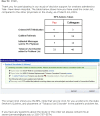Design and implementation of decision support for tobacco dependence treatment in an inpatient electronic medical record: a randomized trial
- PMID: 28194729
- PMCID: PMC5526813
- DOI: 10.1007/s13142-017-0470-8
Design and implementation of decision support for tobacco dependence treatment in an inpatient electronic medical record: a randomized trial
Abstract
Tobacco dependence treatment for hospitalized smokers results in long-term cessation if treatment continues at least 30 days post-discharge. Health information technology may facilitate ongoing tobacco dependence treatment after hospital discharge. To describe the use and impact of a new decision support tool and order set for inpatient physicians, addressing tobacco dependence treatment for hospitalized smokers, embedded in an electronic health record (EHR). In a cluster-randomized trial, 254 physicians were randomized (1:1) to either receive or not receive the decision support tool and order set, which were embedded in the Epic (Madison, WI) EHR used at 2 hospitals in a single city. When an adult patient was admitted to a medical service, an electronic alert appeared if the patient was coded in the EHR as a smoker. For physicians randomized to the intervention, the alert linked to an order set to prescribe tobacco treatment medications and refer the patient to the state tobacco quitline. Additionally, "tobacco use disorder" was added to the patient's problem list, and an e-mail was sent to the patient's primary care provider (PCP). In the control arm, an alert fired with no screen visibility. Generalized estimating equations were used to model the data. Since August 2013, the alert has appeared for 10,939 patients (5391 intervention, 5548 control). Compared to control physicians, intervention physicians were more likely to order tobacco treatment medication (35 vs. 29%, P < 0.0001), populate the problem list with tobacco use disorder (41 vs. 2%, P < 0.0001), and make a referral to the state smokers' quitline (30 vs. 0%, P < 0.0001). In addition, intervention physicians sent an e-mail to the patient's PCP 4152 (99%) times. Designing and implementing an order set and alert for tobacco treatment in an EHR is feasible and helps physicians place more orders for tobacco treatment medication, referrals to the state smokers' quitline, and e-mails to patients' PCPs. Data on cessation outcomes are pending.
Trial registration: www.ClinicalTrials.gov (NCT01691105).
Keywords: Decision support; Electronic health records; Smoking cessation; Tobacco dependence treatment.
Conflict of interest statement
Funding
This study was supported by R18HL105208 from the National Heart, Lung, and Blood Institute of the National Institutes of Health.
Conflict of interest
The authors declare that they have no competing interests.
Figures







References
Publication types
MeSH terms
Associated data
Grants and funding
LinkOut - more resources
Full Text Sources
Other Literature Sources
Medical

